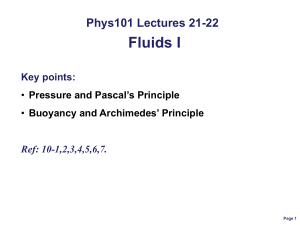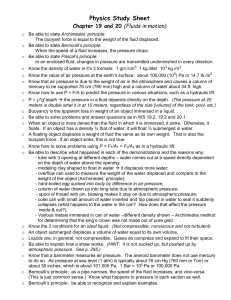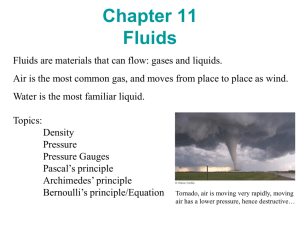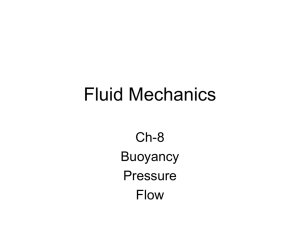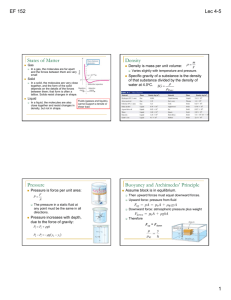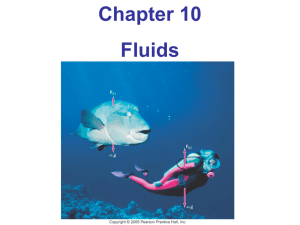Slide 1
advertisement
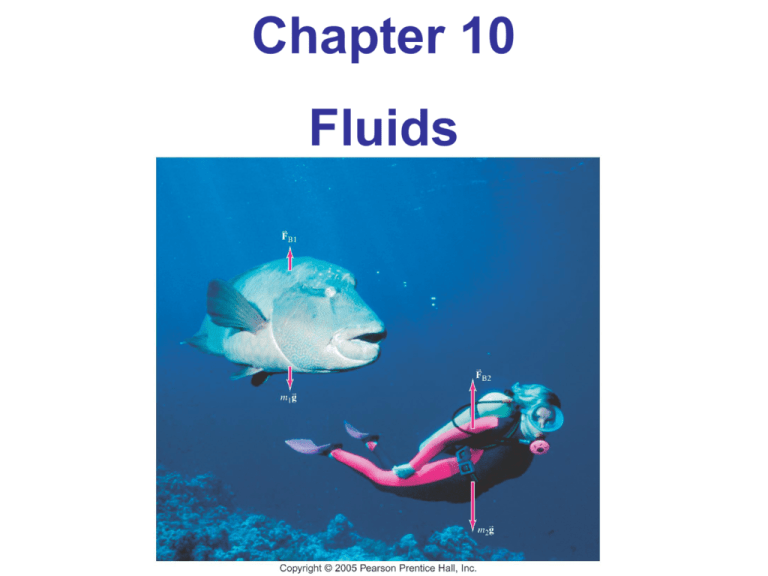
Chapter 10 Fluids Units of Chapter 10 •Phases of Matter •Density •Pressure in Fluids •Atmospheric Pressure and Gauge Pressure •Pascal’s Principle •Measurement of Pressure; Gauges and the Barometer •Buoyancy and Archimedes’ Principle Units of Chapter 10 •Fluids in Motion; Flow Rate and the Equation of Continuity •Bernoulli’s Equation •Applications of Bernoulli’s Principle: from Torricelli to Airplanes, Baseballs, and TIA •Viscosity •Flow in Tubes: Poiseuille’s Equation, Blood Flow •Surface Tension and Capillarity •Pumps, and the Heart 10-1 Phases of Matter The three common phases of matter are solid, liquid, and gas. A solid has a definite shape and size. A liquid has a fixed volume but can be any shape. A gas can be any shape and also can be easily compressed. Liquids and gases both flow, and are called fluids. 10-2 Density and Specific Gravity The density ρ of an object is its mass per unit volume: (10-1) The SI unit for density is kg/m3. Density is also sometimes given in g/cm3; to convert g/cm3 to kg/m3, multiply by 1000. Water at 4°C has a density of 1 g/cm3 = 1000 kg/m3. 10-3 Pressure in Fluids Pressure is defined as the force per unit area. Pressure is a scalar; the units of pressure in the SI system are pascals: 1 Pa = 1 N/m2 Pressure is the same in every direction in a fluid at a given depth; if it were not, the fluid would flow. 10-3 Pressure in Fluids Also for a fluid at rest, there is no component of force parallel to any solid surface – once again, if there were the fluid would flow. 10-3 Pressure in Fluids The pressure at a depth h below the surface of the liquid is due to the weight of the liquid above it. We can quickly calculate: (10-3) This relation is valid for any liquid whose density does not change with depth. 10-4 Atmospheric Pressure and Gauge Pressure At sea level the atmospheric pressure is about ; this is called one atmosphere (atm). Another unit of pressure is the bar: Standard atmospheric pressure is just over 1 bar. This pressure does not crush us, as our cells maintain an internal pressure that balances it. 10-4 Atmospheric Pressure and Gauge Pressure Most pressure gauges measure the pressure above the atmospheric pressure – this is called the gauge pressure. The absolute pressure is the sum of the atmospheric pressure and the gauge pressure. 10-6 Measurement of Pressure; Gauges and the Barometer There are a number of different types of pressure gauges. This one is an opentube manometer. The pressure in the open end is atmospheric pressure; the pressure being measured will cause the fluid to rise until the pressures on both sides at the same height are equal. 10-6 Measurement of Pressure; Gauges and the Barometer Here are two more devices for measuring pressure: the aneroid gauge and the tire pressure gauge. 10-6 Measurement of Pressure; Gauges and the Barometer This is a mercury barometer, developed by Torricelli to measure atmospheric pressure. The height of the column of mercury is such that the pressure in the tube at the surface level is 1 atm. Therefore, pressure is often quoted in millimeters (or inches) of mercury. 10-6 Measurement of Pressure; Gauges and the Barometer Any liquid can serve in a Torricelli-style barometer, but the most dense ones are the most convenient. This barometer uses water. 10-7 Buoyancy and Archimedes’ Principle This is an object submerged in a fluid. There is a net force on the object because the pressures at the top and bottom of it are different. The buoyant force is found to be the upward force on the same volume of water: 10-7 Buoyancy and Archimedes’ Principle The net force on the object is then the difference between the buoyant force and the gravitational force. 10-7 Buoyancy and Archimedes’ Principle If the object’s density is less than that of water, there will be an upward net force on it, and it will rise until it is partially out of the water. 10-7 Buoyancy and Archimedes’ Principle For a floating object, the fraction that is submerged is given by the ratio of the object’s density to that of the fluid. 10-7 Buoyancy and Archimedes’ Principle This principle also works in the air; this is why hot-air and helium balloons rise. Summary of Chapter 10 • Phases of matter: solid, liquid, gas. • Liquids and gases are called fluids. • Density is mass per unit volume. • Specific gravity is the ratio of the density of the material to that of water. • Pressure is force per unit area. • Pressure at a depth h is ρgh. • External pressure applied to a confined fluid is transmitted throughout the fluid. Summary of Chapter 10 • Atmospheric pressure is measured with a barometer. • Gauge pressure is the total pressure minus the atmospheric pressure. • An object submerged partly or wholly in a fluid is buoyed up by a force equal to the weight of the fluid it displaces. • Fluid flow can be laminar or turbulent. • The product of the cross-sectional area and the speed is constant for horizontal flow.
